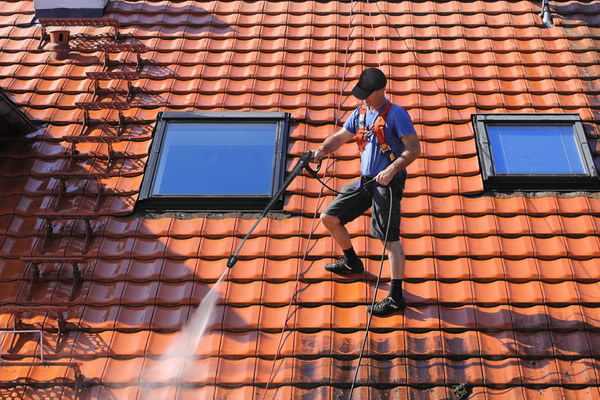Is Roof Cleaning Necessary? Everything You Didn't Know About Scrubbing Your Shingles
Author: Amy Freeman | November 4, 2019
You're looking up at your roof and notice that there's some black stuff growing on some of the shingles. What is it? Mold, mildew or soil that somehow made its way up there? Is roof cleaning necessary?

Most likely, that unidentifiable sludge is algae. According to the Asphalt Roofing Manufacturers Association (ARMA), algae grows on roofs in areas where water or moisture collect. The spores reach the roof by a combination of birds and wind.
If you notice green fuzzy areas on your roof, on the other hand, you most likely have moss growing. Shade and moisture create an ideal habitat for moss growth.
If you see moss or algae on your roof, what should you do? Is roof cleaning necessary, or should you leave it alone?
Pros and Cons
One reason to clean your roof is to extend the life of your shingles or other roofing material. While algae isn't harmful to asphalt shingles, moss is, according to ARMA. Moss can make the edges of the shingles curl upward, making them more likely to blow off the roof during windy weather.
Although algae won't harm your shingles, it can negatively affect their performance. That's particularly true if you have a reflective or cool roof. Black algae growth will interfere with the reflective properties of the roof.
One of the drawbacks of roof cleaning is that it can be a hassle . You probably aren't exactly thrilled about the idea of climbing up on your roof and hosing it down, or using a chemical cleaner to kill off the algae or moss. Luckily for you, the National Roofing Contractors Association advises against any DIY work on your roof, including cleaning it. Roof cleaning is a job to leave to the pros.
Another potential issue with roof cleaning is that the cleaning product used (usually bleach) can harm any garden plantings or vegetation growing near your home. Your roofing contractor should water any nearby plants and cover them to protect them from chemicals before cleaning your roof.
What's Involved in Roof Cleaning?
During roof cleaning, the focus is on killing and removing the algae or moss growth. Chlorine bleach, the same kind you use to whiten laundry or scrub your toilet, is enough to kill off moss and algae spores. The ARMA recommends a 1:1 ratio of bleach to water to clean a roof. They also advise against using a pressure washer on asphalt shingles, as the force of the water can damage them.
After being allowed to sit on the roof surface for up to 20 minutes, the bleach solution should be rinsed away with clean water. A few rain showers should be enough to wash any remaining algae off the roof. The person cleaning your roof might also use a leaf blower to remove any leftover pieces of moss.
Should You Clean or Replace Your Roof?
If you're looking at your roof and thinking it looks a little worse for wear, it might just need a good cleaning. Sometimes, the buildup of algae and moss on a roof can make the shingles look like they are in worse condition than they really are. A professional roofing contractor can inspect your roof and talk to you about its condition. If they think that cleaning it is the best option, they can either do the work themselves or direct you to a reputable roof cleaning company.
If it does turn out that your roof needs replacement, your contractor might recommend shingles that contain copper or another material that helps to repel algae growth. A roofing pro can also give you tips on keeping your roof clean and how frequently to schedule cleanings.